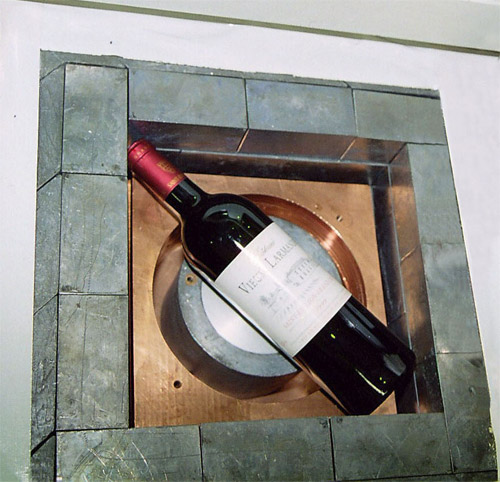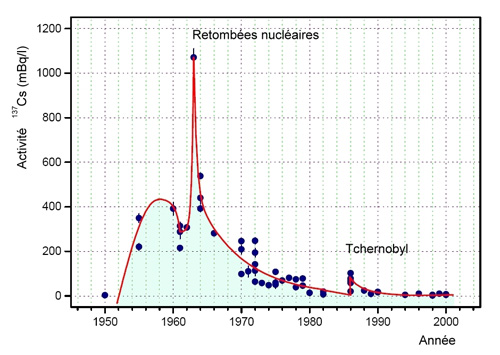How to use radioactivity to authenticate a vintage
Large quantities of artificial radionuclides from the fission of uranium were released into the atmosphere during the atmospheric nuclear tests of the 1950s and 1960s. Today, there remain only radioelements having a long radioactive period such as caesium-137 (Cs137) with a half-life of 30 years. Since the nuclear tests, this caesium was deposited over time more or less evenly throughout the globe and in particularly on the vines. It is normal to find traces of Cs137 on the grapes and therefore in the wine. However, the corresponding level of radioactivity is extremely low, about 0.01 to 1 Bq per liter of wine, well below that of natural radioactivity.
per liter of wine, well below that of natural radioactivity.

Vintage bottle being analyzed
Bottle of a great Bordeaux vintage being analyzed over a low background germanium detector surrounded by a shield of lead and copper. The aim of this analysis is to check the authenticity of the vintage.
© CENBG
That’s why it took until the late 1990s and the development of low background germanium (Ge) semiconductor detectors, sensitive to very low levels of radioactivity, to highlight the presence of Cs-137 in the wine and variation in its activity as a function of years. This study was carried out by various laboratories near Bordeaux on the vintages of the Bordeaux vineyards between 1950 and 2000.

Variation of the activity of Cs137 over time in wines
Curve of Cs-137 activity (millibecquerels / Liter) of Bordeaux wines according to their year of production. This curve is used as a benchmark for determining whether a wine is authentic or fraudulent.
© CENBG
In addition to the peaks of activity due to atmospheric nuclear tests between 1952 and 1964, a peak due to the accident at the Chernobyl nuclear power plant is observed in 1986. This reference curve can therefore « date » the wine or at least determine if a wine is authentic in view of the expected activity in Cs-137. This method is even foolproof for vintages prior to 1950 where traces of Cs-137 are not expected. Thus, it is therefore possible by this technique to identify fraud for great vintages.
The great advantage of this technique is that it is nondestructive. Indeed, the nuclei of Cs-137 emit gamma radiation of 662 keV  that easily passes through the glass of the bottle and then can be detected.
that easily passes through the glass of the bottle and then can be detected.
Another characterization method has been developed by the PIXE technique. By analyzing the chemical composition of glass, it allows dating the glass of the bottle.
Other articles on the subject « Radioactive Dating »
Radiocarbon Dating
Find the age of a bygone object by counting Carbon-14 decays The most common of the radioactive d[...]
Thermoluminescence
Dating by releasing the energy stored by the radioactivity Many minerals emit light when heated. [...]
Dating in geology
Going back to the distant past In order to date old geological material, geologists rely on radio[...]